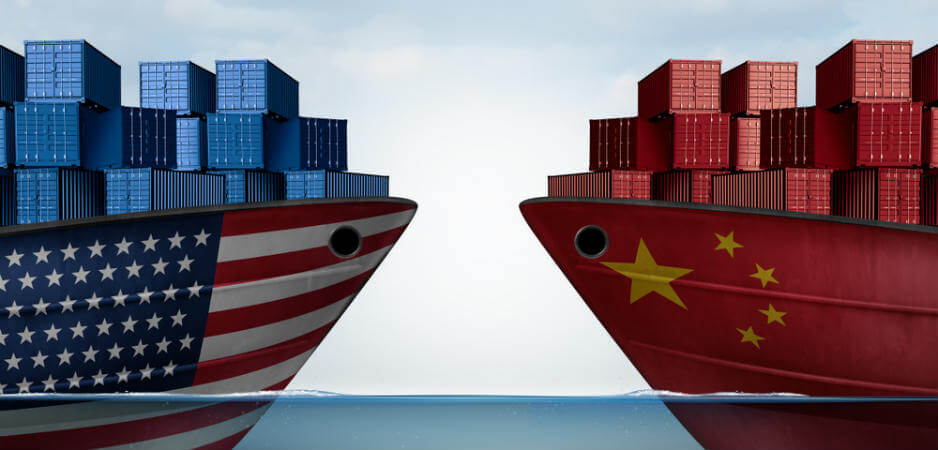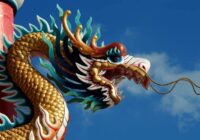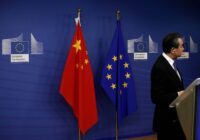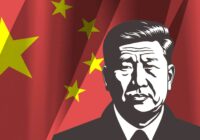Those China tariffs aren’t surprising. What’s bizarre are the people praising Trump’s recklessness and reviving his political fortunes.
By slapping tariffs on Chinese imports, Donald Trump has once again proven to be the Disrupter-in-Chief. This week alone, he’s brought John Bolton in as national security advisor over the objections of every sane person in the universe, threatened to go after Bashar al-Assad over the Syrian leader’s alleged use of chemical weapons and revived disgusting characterizations of Mexicans as rapists. Who can even remember Russiagate or Stormy Daniels with these non-stop disruptions? As Bob Odenkirk jokes in The New Yorker, you’d easily miss the birth of your own grandchild so transfixed are you by the news of the daily car wreck known as the Trump presidency.
The tariffs, however, might prove to be the most significant disruption of all. Trump hasn’t just pissed off more than a billion Chinese. He’s enraged economists, foreign policy professionals and soybean farmers in this country as well. He sent the stock market into a dive. Indeed, a trade war with China threatens to overturn the entire global economy.
At first glance, Trump’s move seems to make little political sense. He’s going against a good chunk of his own party, which has uncritically embraced free trade for years. The president’s moves may complicate Republican chances in the mid-term elections, since Republican candidates must now either run against the president on a pocketbook issue or unconvincingly change their stripes at the last moment. But Trump’s move may preserve (or even expand) his own base of support in key swing states — and thus his chances for reelection in 2020.
Don’t underestimate Trump’s willingness to destroy his party, his country and the global economy in his quest to make himself “great” for a second term. On the tariff question, the surprising thing is not Trump’s decision. After all, he’s been touting tariffs ever since he began talking politics back in the 1980s. What’s truly bizarre are some of the people who are praising his recklessness and thus reviving his political fortunes.
Strange Bedfellows
Trade used to be a relatively easy political litmus test. Democrats, responding to their political base of unions, inveighed against free trade in favor of “fair trade.” As the party of the plutocrats, Republicans generally supported anything on the agenda of Wall Street and transnational corporations, which generally want the removal of all barriers to the free flow of money and goods.
The Democrats, however, began to shift in favor of free trade back in the 1990s with Bill Clinton’s embrace of NAFTA. Trump, meanwhile, represents a popular pushback by Republican rank and file. According to Pew polling, 67% of Democratic voters now support free trade agreements, but only 35% of Republicans feel the same way.
Not all Democrats feel that way, of course. As a traditional Democrat from the strong union state of Ohio — one of the few places where union membership actually went up in 2016 — Sherrod Brown has staked out a claim as one of the more progressive politicians in Congress. But Ohio is also a state that Donald Trump won by a convincing 8% of the vote in 2016. Since the election, Brown has cannily supported the president on certain issues, including the much-vaunted infrastructure plan, which Brown sees as a potential job creator for his state.
Brown has also long opposed trade deals like NAFTA and the Trans Pacific Partnership (TPP). No surprise, then, that he immediately embraced Trump’s tariffs. “This welcome action is long overdue for shuttered steel plants across Ohio and steelworkers who live in fear that their jobs will be the next victims of Chinese cheating,” he said. “If we fail to stand up for steel jobs today, China will come after other jobs up and down the supply chain tomorrow.” Brown’s support of the new tariffs makes political sense, even if his willingness to partner with an autocratic president is morally dubious.
The political positions of Fareed Zakaria, the prominent CNN and Washington Post pundit, are usually antithetical to Sherrod Brown’s. Zakaria is generally an enthusiast for free trade and globalization. He was a fan of the TPP. He routinely bashes what he calls socialist or quasi-socialist government policies that remind him of what didn’t work in the India of his childhood in the 1970s. Back in June 2016, Zakaria wrote that “it is stunning that serious conservative Republicans who are devoted to free-market ideas are backing Trump, looking the other way and crossing their fingers. The cost of doing so is now clear: Trump will transform the GOP into a protectionist, nationalist party.”
Zakaria is clearly no fan of Trump. And yet, he’s come out in favor of the very tariffs that are central to the Republican Party’s transformation that Zakaria so fears. The reason for Zakaria’s turnabout is his conclusion that “China is a trade cheat.” He argues that China’s trade policies have cost America tens of thousands of jobs and that China has engaged in routine corporate espionage and copyright infringement.
But there’s something else that irritates Zakaria about China’s behavior (as well as that of India and Brazil). “Today the greatest threat to the open world economy comes from these large countries that have chosen to maintain mixed economies, refuse to liberalize much more, and have enough power to hold firm,” he writes in his latest Post op-ed.
Trump, Brown and Zakaria have very different economic visions. Zakaria is a globalist, Brown is an old-fashioned progressive and Trump is a nationalist. All three, however, view China opportunistically as a useful enemy to wave in front of the electorate. China is certainly a convenient target. But is it really cheating? And are tariffs the best way to address the situation?
Are China’s Pants on Fire?
China once was the world economy. It manufactured porcelain, produced silk, grew tea and printed books. It exported throughout Asia and, via the Silk Road, to the West as well. By the 20th century, however, China had fallen far behind the West. Beginning with agricultural reforms in the late 1970s, China began to close the gap. To do so required both traditional techniques, such as using the comparative advantage of cheap labor, and somewhat more unorthodox approaches, like government subsidies of promising industries.
If China had stuck with what it was good at producing in the 1970s, it would today be a poor agricultural country making a modest income from selling cheap rice and trinkets to the world. To get to its current position as a global economic superpower, China had to break the rules — just as Japan and South Korea had previously done to catch up to the West.
What irritates US critics is that China, in their eyes, continues to break the rules even though it’s become the second largest economy in the world. Those transgressions have included currency manipulation, targeted government subsidies and more systemic “distortions” of the Chinese economy. For the longest time, China’s greatest sin in the eyes of the United States was its currency manipulation: devaluing the yuan in order to make its exports cheaper (and imports more expensive). With the exception of a brief devaluation in early 2016, however, China has been strengthening the yuan against the dollar for more than a decade. From 2005, the yuan has appreciated 33% against the dollar. Moreover, since Trump took office, the yuan has risen 9% against the dollar.
Indeed, it’s only now that a trade war is on the horizon that China is once again considering adjusting the value of its currency as a weapon against the United States. Nice job, Donny!
The Chinese government also stands accused of using various policies to promote its industries. For instance, a huge sustainable energy program — including a push to spend $360 billion on renewable energy by the end of this decade — has helped China become a leading producer of wind power generators, solar panels and the like. This is not some crazy Communist conspiracy. Most countries implement some form of industrial policy, by which governments subsidize or otherwise support potential economic winners. In the United States such a policy is called, simply, the Pentagon. (And you thought perhaps that the Defense Department’s invention of the internet was just a lucky shot in the dark?)
A third US complaint centers around the level of tariffs — for instance the 25% rate China slaps on auto imports. That number is accurate, but China still imports six US cars for every one car it exports to the United States. In other words, the tariff doesn’t serve as much of a barrier to US sales (except perhaps on high-end vehicles). Meanwhile, it’s also true that the US tariff on Chinese cars is only 2.5% — but critics usually fail to mention the 25% tariff that Washington imposes on Chinese trucks. Chinese tariffs are also much lower on auto parts. Over all, according to 2017 data, the average tariff imposed by the Chinese government is 9.9%. True, that contrasts with only 3.5% for the United States. But China also clocks in considerably lower than South Korea (14. 9%), Brazil (13.5%) and India (13.4%).
Envy and Anger
Then there’s the issue that Trump has brought up of the requirement China imposes on foreign corporate partners to enter into a 50-50 joint venture with Chinese companies that presumably want to siphon off the intellectual property of the outsider investor. As economist Lawrence Summers points out, however, the US companies in question are largely interested in outsourcing their production. “It is more than a little ironic that an administration that condemns outsourcing should make standing up for those who move production to China so central a priority,” he writes.
In fact, as Summers points out, China has been quite responsive over the years to negotiations on trade issues: “China’s global surpluses are now far below the U.S. negotiating targets of a few years ago, China has spent about $1 trillion propping up its currency, and intellectual-property protections are far better enforced.”
Underlying much of the critique of China is something else entirely: envy and anger that an economic system different from the US has succeeded so remarkably. Zakaria, for instance, censures China for its refusal to “liberalize much more.” But liberalization is not just about reducing tariffs, which China has been doing as a member of the World Trade Organization. Proponents of liberalization want to see the Chinese government privatize lucrative state-owned industries and make it easier for foreigners to own those industries. Given its history — and the reasons for that long interregnum between economic dominance in the 18th century and today — China is particularly sensitive about being carved up by foreigners.
Whatever position you might take on China’s economic policies, tariffs are not going to do anything to reverse the trade imbalance with the United States or magically produce more jobs for Americans in the steel or auto sectors. The bottom line is that the United States should consider copying China, not criticizing it. The US government should be investing in the modernization of key industries, pouring money into the retraining of American workers and implementing a large-scale infrastructure development program that relies heavily on domestic sourcing. That’s where at least half of the Pentagon’s budget should be going, not preparing for some future non-trade war with China.
Looking to 2020
Trump has generally gotten along with Xi Jinping. He’s repeatedly praised the Chinese leader, continuing to do so even as the trade war heats up. It’s possible that the two countries will negotiate away their differences behind the scenes, which they could have done without all the tit-for-tat drama of the recent tariff-slinging. In fact, China has already shown some flexibility.
But China represents something else for Trump. It’s the fulcrum of the economic nationalism that Steve Bannon brought to the White House, a way for Trump to keep enflaming his base of support in pivotal states in the lead-up to the 2020 election. Trump is following the Bannon playbook — to remake the Republican Party. The trade issue is the tip of the spear of this strategy.
The Democrats are likely to win back the House in 2018, and they have a shot at getting the Senate as well. That might pose a problem for Trump on a number of fronts, including immigration and the environment. But on economic issues, Trump could very well partner with Democrats and cut out all the Republicans who remain wedded to the “globalist” model.
That’s a nightmare scenario for Mitch McConnell, Paul Ryan and the Koch crowd. But start preparing yourself for the prospect of Donald Trump running again in 2020 on a trans-partisan platform of economic nationalism that touts his “achievements” on trade and infrastructure. Such a pitch will appeal to precisely the swing states that supported him in 2016, and that’s a nightmare scenario for more than just a handful of rich Republicans.
Support Fair Observer
We rely on your support for our independence, diversity and quality.
For more than 10 years, Fair Observer has been free, fair and independent. No billionaire owns us, no advertisers control us. We are a reader-supported nonprofit. Unlike many other publications, we keep our content free for readers regardless of where they live or whether they can afford to pay. We have no paywalls and no ads.
In the post-truth era of fake news, echo chambers and filter bubbles, we publish a plurality of perspectives from around the world. Anyone can publish with us, but everyone goes through a rigorous editorial process. So, you get fact-checked, well-reasoned content instead of noise.
We publish 2,500+ voices from 90+ countries. We also conduct education and training programs
on subjects ranging from digital media and journalism to writing and critical thinking. This
doesn’t come cheap. Servers, editors, trainers and web developers cost
money.
Please consider supporting us on a regular basis as a recurring donor or a
sustaining member.
Will you support FO’s journalism?
We rely on your support for our independence, diversity and quality.








